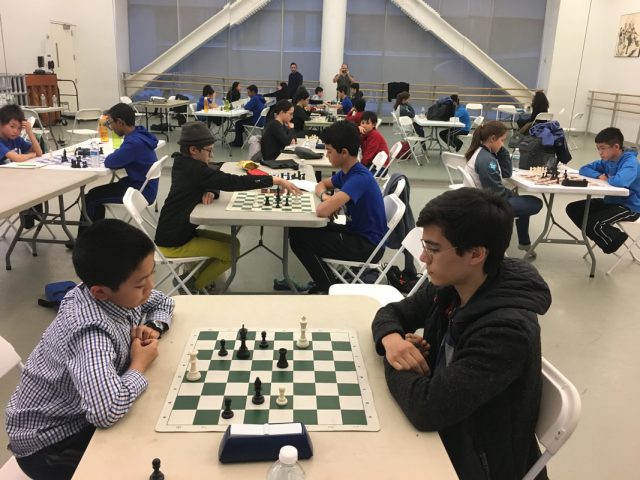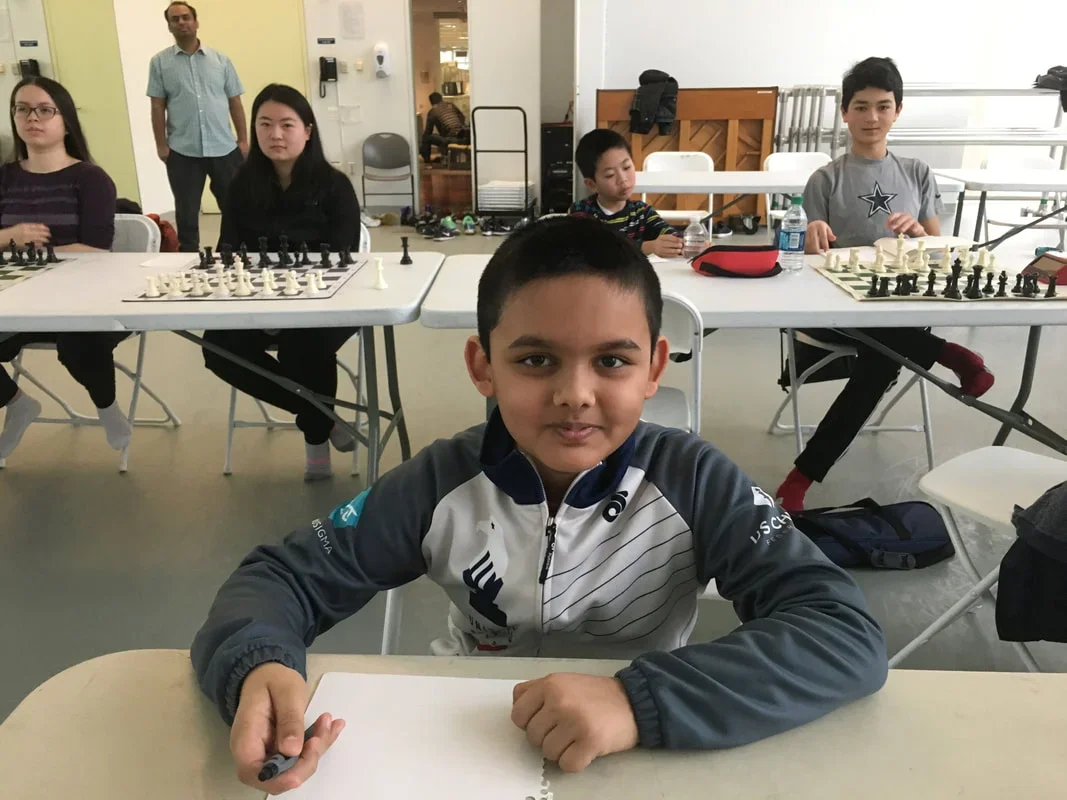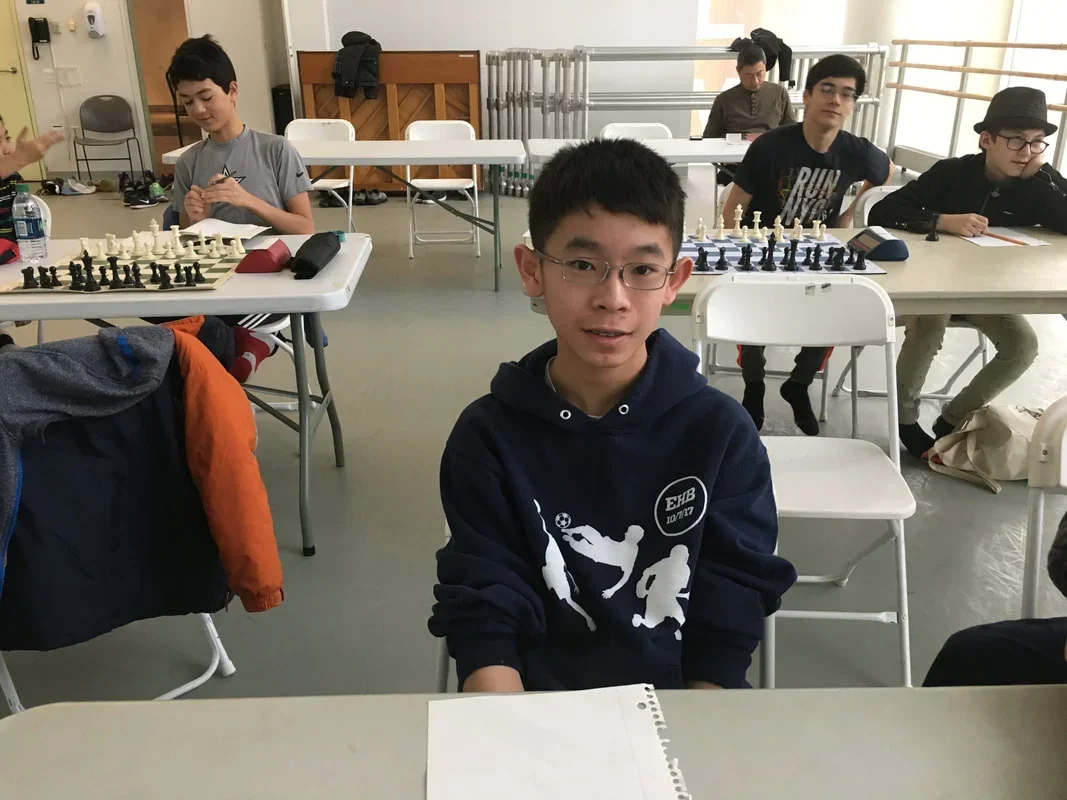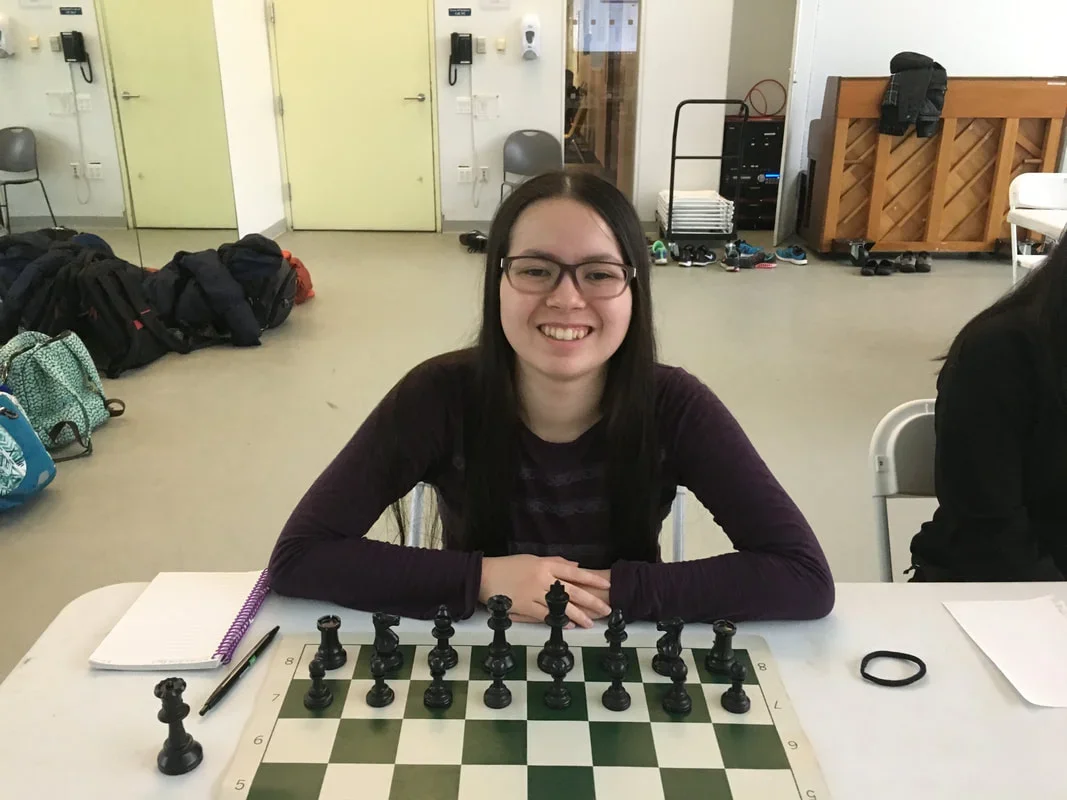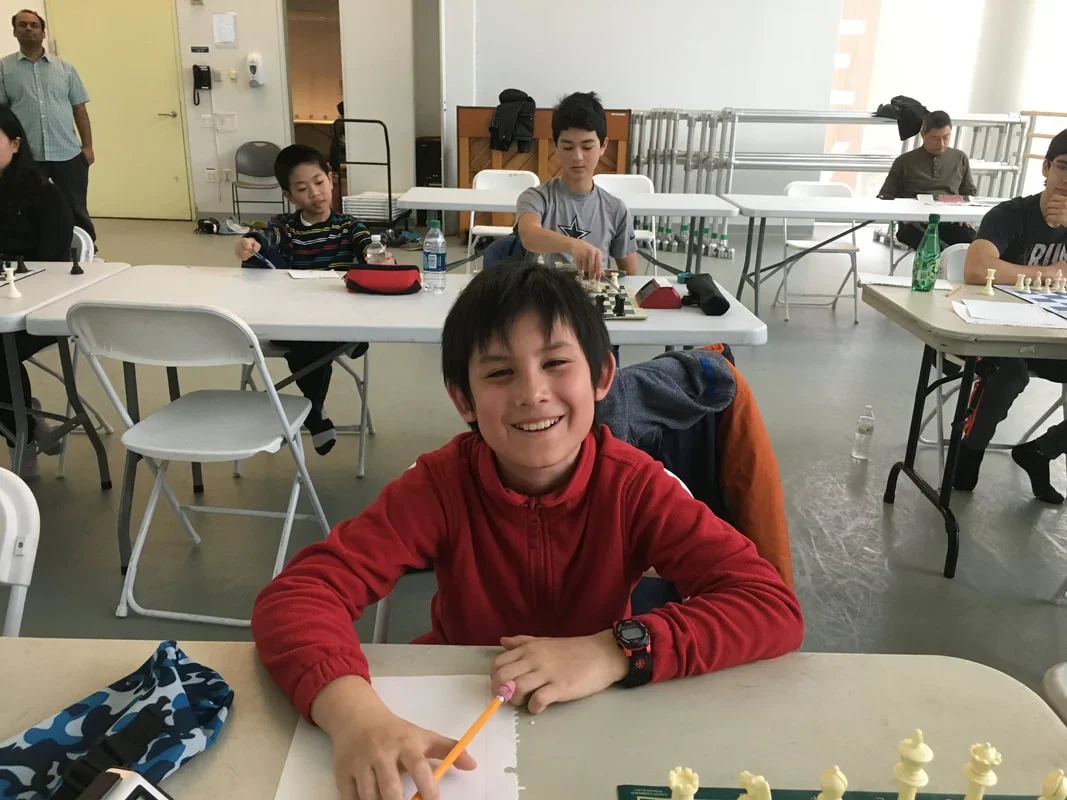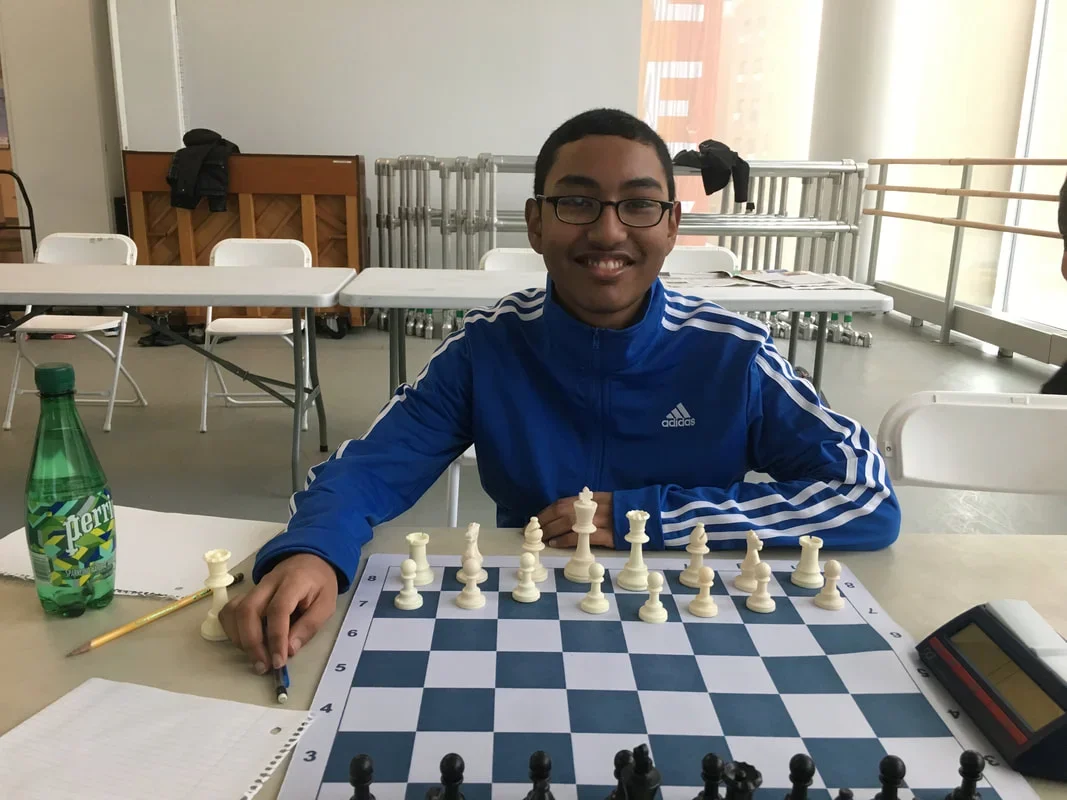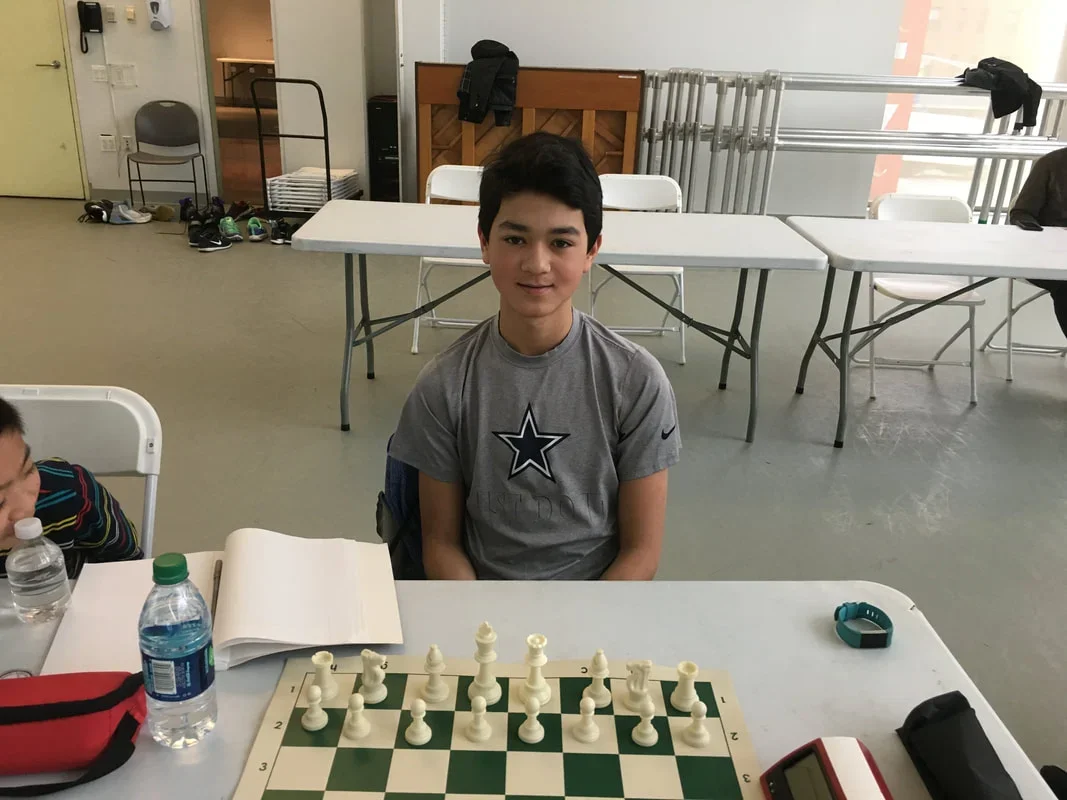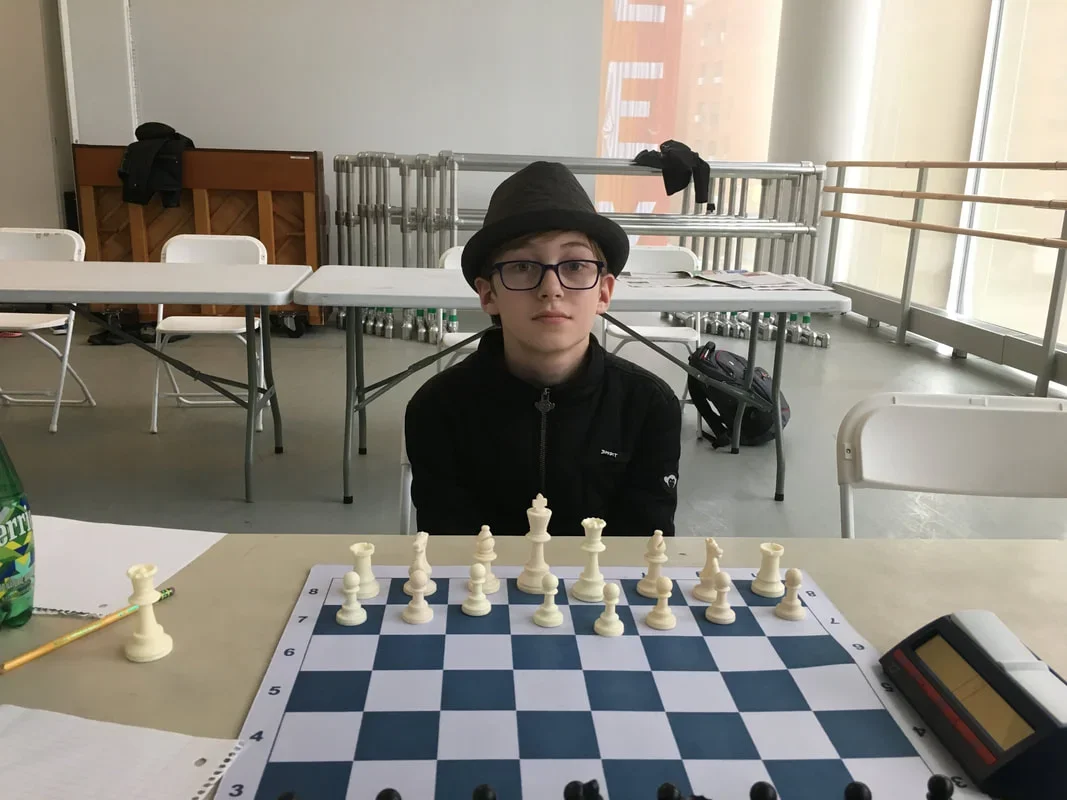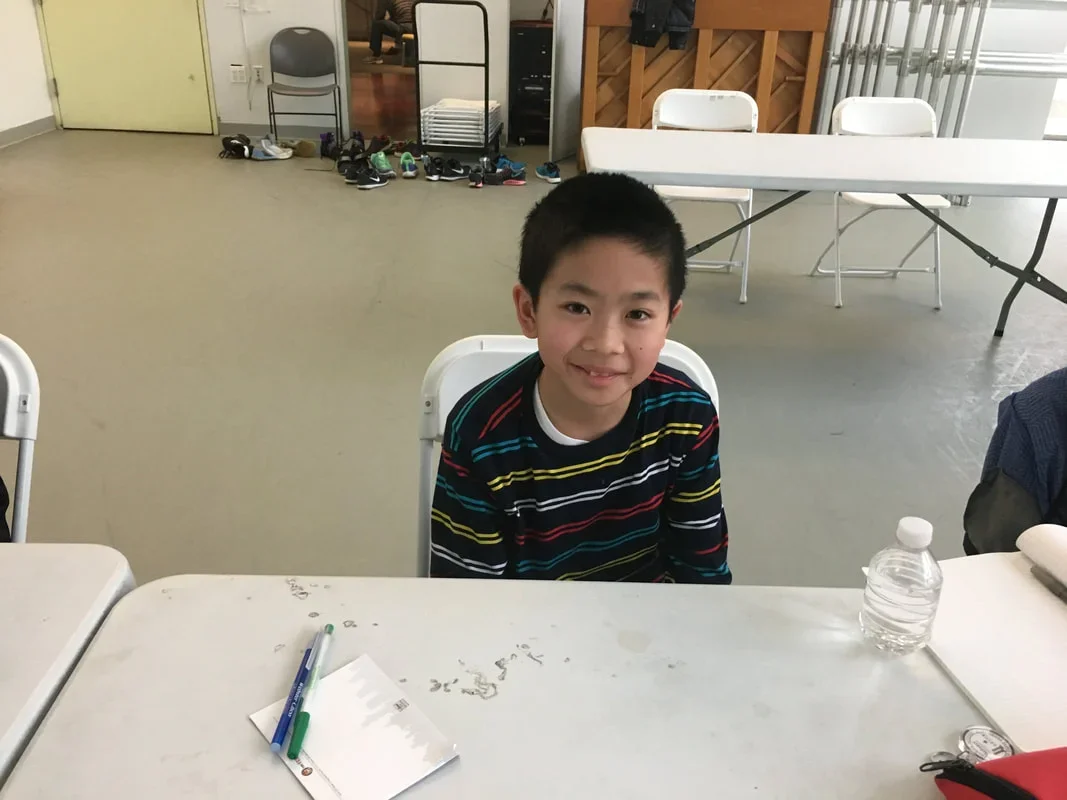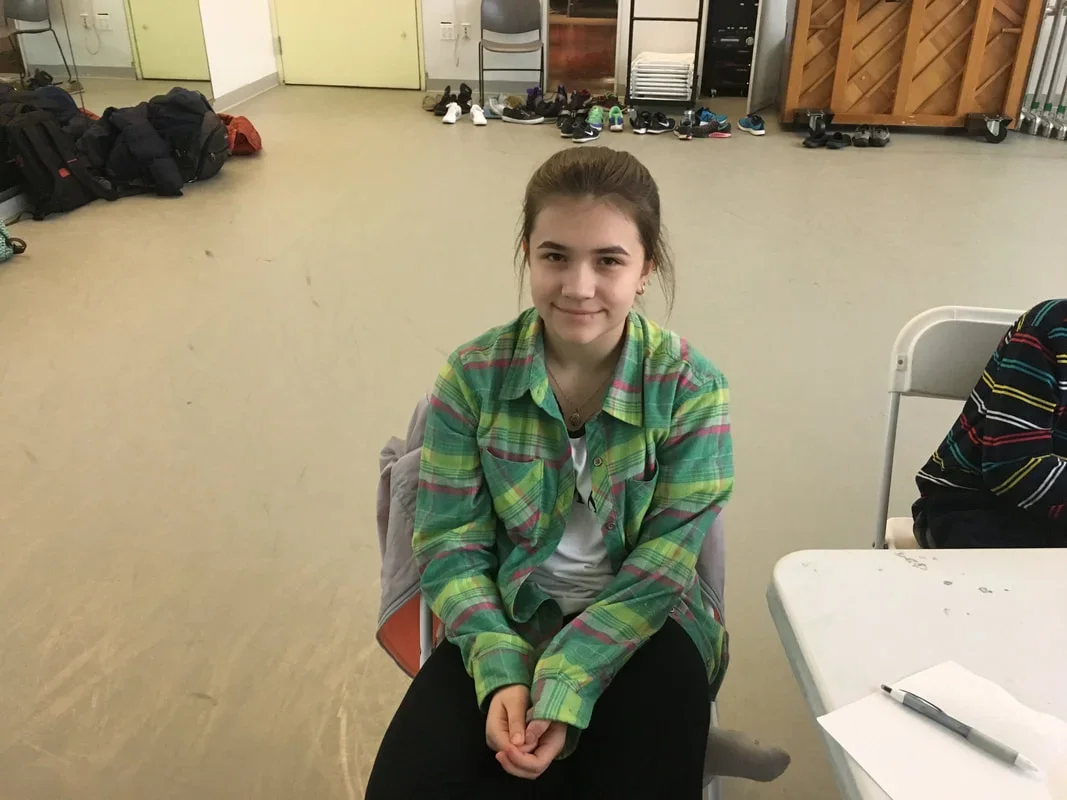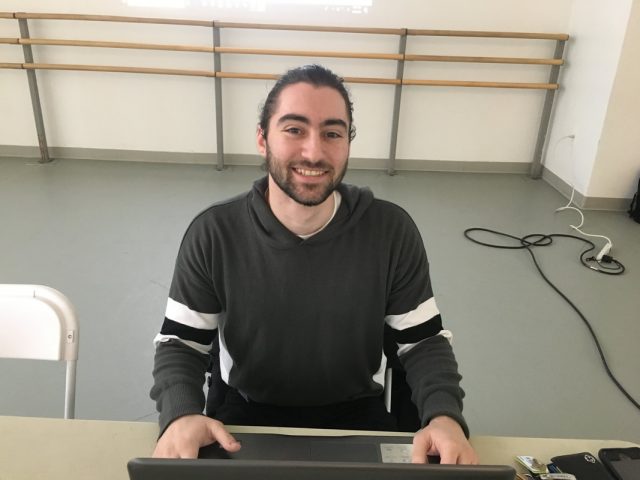Over the board, we search for time, harmony, and space. In New York City, all three of these are elusive . . . especially space. So my question to you is: what is better than a US Chess Camp in New York City? How about a US Chess Camp in a Modern dance studio in New York City? While dancers were practicing their moves in the other studios, we were practicing our moves over the board. Is chess an art? A sport? A dance of sorts? Needless to say, we fit right in!
US Chess School Camps never fail to come through as my most exciting and productive training sessions. Because the camp was during spring break, our ability to completely focus on chess made learning that much more possible -- and for me, fun. There were twelve of us that were lucky enough to attend the camp. You can see our chess mug shots below!
The main coach for the camp was IM Alex Ostrovskiy, who attended the camps about ten years ago himself. Greg Shahade was kind enough to organize this camp and contributed intuition tests (which I discovered I need to get a lot better at).
Out of many camps I’ve been to, this one stood out the most. The typical chess camp focuses on learning and practicing calculation, tactical and positional play through common chess knowledge and concepts such as prophylaxis and weak squares. While still covering all of these essential concepts, what set this camp apart from the rest was the novel approach that our coach IM Alex Ostrovskiy took. While he taught us high-level theory, he taught it in a way that was more practical and useful than most books you can read.
I’ve heard many times that a bad plan is better than no plan at all. Obviously this is not a rule that is set in stone, and in many cases it is not true at all, however the logic behind it is correct. Having a sense of direction in the game, and an idea to execute throughout the following moves is a crucial part of the game. In my personal experience, having any kind of plan gives me a sense of confidence and optimism in my game, even if I am slightly worse. However, it is easy to forget the difficulty of coming up with a plan. Many times, I find myself in a game making pattern moves without any sense of direction, and letting my opponent dictate the pace and flow of the game. Especially in critical moments, where the tide of the game can be decided within the next couple moves, having a plan is extremely important. The first lesson at this U.S Chess School dealt with this problem directly. In his book Positional Play, GM Jacob Aagaard addresses this issue, advocating for a three point plan that consists of the following questions:
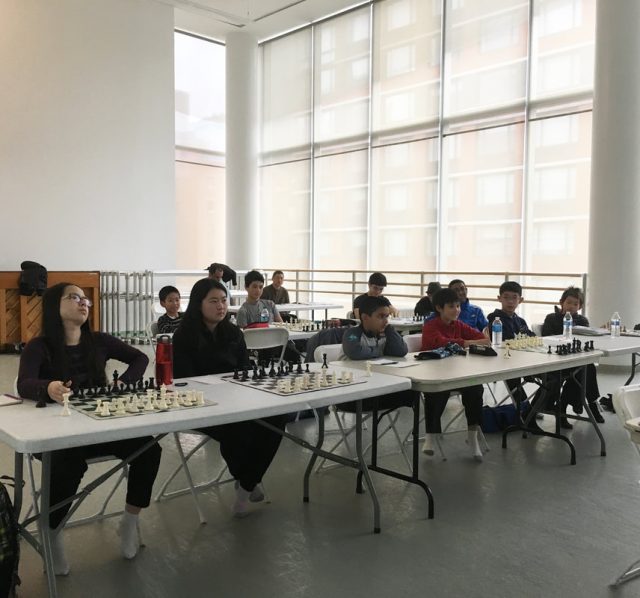 This game is a good segue into the next topic of discussion, stewing and lulling, two terms that Aleksander Ostrovskiy introduced to us. Stewing means letting your opponent marinate in his worse position until he makes a mistake. Lulling is a similar but slightly different concept in which in order to win a slightly better position that is objectively drawn, you make tons of moves in order to lull your opponent into a sense of false security -- and then strike. These techniques are especially good for winning those annoying endgames where you’re slightly better but can’t break through.
Ostrovsiky- Khamrakulov
I spent a ridiculous amount of time on this position. I came close to finding the best plan but failed to grasp all the details. How should White continue? In your analysis you need to figure out the 'essential element of the position.'
This game is a good segue into the next topic of discussion, stewing and lulling, two terms that Aleksander Ostrovskiy introduced to us. Stewing means letting your opponent marinate in his worse position until he makes a mistake. Lulling is a similar but slightly different concept in which in order to win a slightly better position that is objectively drawn, you make tons of moves in order to lull your opponent into a sense of false security -- and then strike. These techniques are especially good for winning those annoying endgames where you’re slightly better but can’t break through.
Ostrovsiky- Khamrakulov
I spent a ridiculous amount of time on this position. I came close to finding the best plan but failed to grasp all the details. How should White continue? In your analysis you need to figure out the 'essential element of the position.'
- What are the weaknesses?
- What is the worst piece?
- What is my opponent intending?
- What are the weaknesses?
- What is the worst piece?
- What is my opponent intending?
- Where is my play?
- What is the essential element of the position?
[pgn]
[Event "Critical Moments"]
[Site "?"]
[Date "2018.01.13"]
[White "Ostrovskiy, Aleksandr"]
[Black "Zierk, Steven"]
[Result "1-0"]
[ECO "A28"]
[WhiteElo "2484"]
[BlackElo "2560"]
[Annotator "Ostrovskiy, Aleksandr"]
[SetUp "1"]
[FEN "r1b1r1k1/1pp1np1p/1b1p1p2/pP2p3/2PP4/P3PN2/1B3PPP/R3KB1R b KQ - 0 14"]
[PlyCount "46"]
[EventDate "2016.??.??"]
[SourceDate "2011.03.27"]
14... c5 {My opponent was unfamiliar with the opening and was forced to come
up with his own plans early. For me, this was the first moment of the game
that I had to think. My first reaction was to calculate all the captures and
defenses, but when I asked myself about the position's defining feature I
quickly found the solution} 15. dxe5 $1 {Black's previous move had the
intention to activate the Bb6. By playing dxe5 I am preventing the
activization of his worst piece! Once I realized this detail the moves became
so simple!} (15. dxc5 Bxc5) (15. O-O-O $2 cxd4) (15. bxc6 Nxc6) (15. d5 {
is acceptable but not as strong as the game continuation: 1. Black's structure
is better here than in the game 2. The open position allows White to best take
advantage of his superior piece communication (Space Advantage)}) 15... dxe5
16. g4 $5 {Fixing Black's pawn structure while potentially preparing future
Rg1-g5 ideas. The Black queenside pieces will be in effective in the kingside
assault!} (16. Nd2) 16... Ng6 {My opponent offered me a draw here but my
position is way too powerful} 17. Rg1 {Directing play to the kingside as
Black's Bb6 is stuck. Bonus: his structure is also terrible} Bc7 18. Nd2 f5 19.
gxf5 Bxf5 20. Rg5 Bc8 21. Ne4 Bd8 22. Rg1 b6 23. Nd6 Re7 24. Bg2 Rb8 25. Nxc8
Rxc8 26. Ke2 {As often happens, I have partially "cashed-in" on my initiative.
As a result I have a technically winning position with a healther pawn
strucure and a monster bishop pair. Black's Bd8 is still struggling due to his
pawn structure} Kf8 27. Be4 Re8 28. Rad1 Rb8 29. Rd7 Bf6 30. Rgd1 Re6 31. a4 {
Do not hurry! Black is in no position to do anything so the quiet a3-a4 is a
sensible way to strengthen the position before proceeding with furthur advances
} Kg7 32. R1d6 Rbe8 33. Rxe6 Rxe6 34. Bd5 Re7 35. Rd6 Nf4+ 36. Kd2 Nxd5 37.
cxd5 {Conclusion: In his training series, GM Artur Yusupov discusses methods
and strategies in coming up with plans. One of his points is to consider the
"Essential Element of the Position." To me, the essential element can be
reworded as "the defining feature of the position." In this game, my critical
decision came on move 15 when my opponent surprised me with an unfamiliar
opening move. Realizing the crux of the position was the attempted excavation
of Bb6, I quickly shut down those plans and converted my advantage} 1-0[/pgn]
Step five in the five point plan is to identify the essential element of the position. Coach Ostrovskiy illustrated how he identified black’s dark-squared bishop as the essential element.With this information we can understand how he found 15.dxe5 and 16. g4. Another interesting try here was 15.d5, however black has ...Bd8 and ...f5 there with the plan of activating the bishop.
Aleks showed us another interesting position from one of his losses:
[pgn]
[Event "Critical Moments"]
[Site "?"]
[White "Ostrovskiy, Aleksandr"]
[Black "Jacobson, Brandon"]
[Result "0-1"]
[ECO "B51"]
[WhiteElo "2484"]
[BlackElo "2479"]
[Annotator "Ostrovskiy, Aleksandr"]
[SetUp "1"]
[FEN "2r2rk1/q2nbppp/p1bppn2/Ppp5/3PP3/2PB1N1P/1P1NQPP1/R1B1R1K1 b - - 0 15"]
[PlyCount "75"]
[EventDate "2017.??.??"]
[SourceDate "2011.03.27"]
15... Rfe8 16. Nf1 Qa8 17. Ng3 Bf8 18. Nh2 $5 {I was struggling to come
up with an effective plan as almost all of my pawns and pieces were already
ideally placed, or so I thought. I came up with my idea after thinking about
my opponents intentions. With his last moves, Black is preparing a standard
maneuver g6-Bg7. While I have the visually more impressive center, my opponent
aims to pressure and chip away with a modern strategy from the flanks. In
particular, he his currently pressuring my e4 pawn with three pieces,
including the distant Qa8. Therefore by realizing that the essential element
of the position revolved around the control of the center, I found a way to
stregthen my position} g6 19. f3 {By defending e4 I am effectively shutting
down his pressure on the long digonal (a8-h1)} Bg7 20. Be3 {As a bonus I can
also develop with Be3 (as the e4 pawn is protected) and nullify his pressure
against d4 as well!} h5 21. Qf2 Bb7 22. b4 $14 cxb4 23. cxb4 Nb8 24. Ne2 Nc6
25. Rab1 Ne7 {With a board full of pieces my space advantage is very
significant. I decide to push forward on the kingside in light of his stranded
queenside Q+B} 26. g4 $5 e5 $5 {Connected with a well timed and practical
response} 27. d5 hxg4 28. hxg4 Nexd5 $1 {This is of course the big idea behind
26..e5 as otherwise Black is suffocating. Now he gets 2 pawns for the piece
and active piece play. Furthermore, the game is approaching the time trouble
phase and a change in the character of the position is often a powerful tool
to defend an inferior game.} 29. exd5 Bxd5 30. Ng3 Rc3 31. Rbd1 Bb3 32. Rd2 d5
33. Bc5 Nd7 34. Bb1 Nxc5 35. bxc5 Qc6 36. g5 Qxc5 37. Qxc5 Rxc5 38. Ng4 Re6 39.
Rde2 Bc4 40. Rd2 e4 41. fxe4 Bc3 42. Red1 Bxd2 (42... Bb3 43. exd5 Bxd2 44.
dxe6 Bxd1 45. e7 Rc8 46. Nf6+ Kh8) 43. Rxd2 b4 44. Nf6+ Kg7 45. Rh2 Rxf6 46.
gxf6+ Kxf6 47. exd5 Rxd5 48. Rb2 (48. Rh4) 48... b3 49. Kf2 Rxa5 50. Ne4+ Kg7
51. Nd2 Be6 52. Ke3 (52. Nxb3 Rb5 53. Bc2 a5 54. Rb1 a4 55. Nd2 Rxb1 56. Nxb1)
52... Ra2 {Conclusion: The idea 18. Nh2!? w/ f3 originated as a result of
considering my opponent's plans and determining the most important feature of
the position. Once again the question of the "Essential Element of the
Position" can prove to be a valuable way to navigate critical junctions of a
game. Of note is my opponent's decision to sacrifice a piece in an unpleasant
position in order to randomize the play. Such a strategy is often useful in
order to throw off an opponent as the game shifted from positional to tactical
territory. Aided by mutual time trouble, Black's stategy eventually resulted
in victory.} 0-1[/pgn]
Keeping in line with Ostrovskiy's nontraditional way of studying chess, the focus of the lessons on the second day of camp was playing equal positions. We all know the feeling of frustration when a lower-rated player is playing only for a draw against us, or has a seemingly unbreakable position. This lesson focused on playing (and hopefully winning) these equal positions. Coach Ostrovskiy showed us that the key to playing these positions was patience. At the rating level of us campers (2100-2400), lower-rated players will almost always make small mistakes that give us chances. Nobody is perfect, so with more or less accurate play, we can capitalize on these small mistakes. Additionally, it is important not to dwell on your frustration, but to maintain a positive attitude while playing out these positions. The key is to look for any plus in your position no matter how slight, because this will encourage you to keep playing with energy and enthusiasm.
Kyle Moon vs. Aleksandr Ostrovskiy
Black to Move
20 ...h5! Play through the full game with explanation below.
[pgn] [Site "?"]
[White "Moon, Kyle"]
[Black "Ostrovskiy, Aleksandr"]
[Result "0-1"]
[ECO "B19"]
[WhiteElo "2100"]
[BlackElo "2535"]
[Annotator "Ostrovskiy, Aleksandr"]
[SetUp "1"]
[FEN "2rr2k1/pp2bpp1/2p1pn1p/8/2PP3P/1PB2N2/P3RPP1/2KR4 w - - 0 20"]
[PlyCount "70"]
[EventDate "2014.??.??"]
[SourceDate "2011.03.27"]
20. Ne5 {Find a plan for Black} h5 $1 {A strong idea for two reasons: 1.
We prevent White's potential kingside expansion with g4 2. We prepare to play
Ne8-Nd6-Nf5-Bf6 (White can't deny us f5 with g4) to target White's d4 pawn.
Although the evaluation of the position is around 0.00, Black is on pace to
overtake the intiative, if not objectively then psychologically! Being able to
execute a 2-3 move mini-plan is a creates an OTB impression that one side is
starting push more than the other.} 21. Kb2 Ne8 22. g3 Nd6 23. Ba5 b6 24. Bc3
Bf6 25. Re3 Nf5 26. Red3 g6 {The mini-plan is complete and now Black needs to
figure out how to make further progress. For now, White is tied down to the d4
pawn. Black can try c5-b5 ideas, or just wait with some other improving moves.
I have often found that a powerful weapon is to "pass" the decisions/moves to
my opponent... they find it hard to stay still and can often make an error!}
27. f4 $2 {A very unforced error that creates permanent structural weaknesses}
(27. Kc2) (27. Kb1) (27. Kc1 {My engine gives these three moves as top choices
for White but it is understandbly difficult to just wait like this. Black can
try some improvement/waiting tactics, for example Bg7+B5}) 27... Bg7 28. b4 {
Both a tactical and positional error} f6 $1 29. Nxg6 (29. Nf3 Nxg3) 29... Kf7
30. g4 hxg4 31. h5 Nd6 32. Kb3 b5 $1 33. c5 Ne4 34. Be1 Rd5 35. Re3 f5 36. Bh4
Rc7 37. h6 Kxg6 38. hxg7 Rxg7 39. a4 a6 40. axb5 axb5 41. Re2 Rh7 {[#]} 42. Rh2
Rhd7 43. Ra2 Rxd4 44. Rxd4 Rxd4 45. Ra6 g3 46. Bxg3 Rd3+ 47. Kc2 Rxg3 48. Rxc6
Kf6 49. Rb6 Rc3+ 50. Kb2 Nxc5 51. Rxb5 Ne4 52. Re5 Rf3 53. b5 Rxf4 54. b6 Nd6 {
Conclusion: While 20...h5! was objectively a strong idea from a positional/
prophylactic perspective, it was also a great strategy in terms of planning.
In balanced positions it is a useful weapon to have a series of mini-plans to
improve your position. This also serves the effect of having your opponent
defend against your plan, in turn creating the feeling of an intiative.
Players tend to react poorly under pressure, and in this game my opponent made
a mistake by playing 27. f4? instead of staying still.} 0-1[/pgn]
This game perfectly exemplifies the concepts talked about above. The resulting endgame from a popular Caro endgame is pretty much +0.00. However, black slowly gains the psychological initiative by maintaining a positive attitude and acting with energy, until finally the lower rated opponent makes an unforced error with f4 -- which ultimately costs him the game. It’s funny, however, that while you try these techniques out on lower rated opponents, players 100-200 points higher than you are doing the exact same thing to you.
 This game is a good segue into the next topic of discussion, stewing and lulling, two terms that Aleksander Ostrovskiy introduced to us. Stewing means letting your opponent marinate in his worse position until he makes a mistake. Lulling is a similar but slightly different concept in which in order to win a slightly better position that is objectively drawn, you make tons of moves in order to lull your opponent into a sense of false security -- and then strike. These techniques are especially good for winning those annoying endgames where you’re slightly better but can’t break through.
Ostrovsiky- Khamrakulov
I spent a ridiculous amount of time on this position. I came close to finding the best plan but failed to grasp all the details. How should White continue? In your analysis you need to figure out the 'essential element of the position.'
This game is a good segue into the next topic of discussion, stewing and lulling, two terms that Aleksander Ostrovskiy introduced to us. Stewing means letting your opponent marinate in his worse position until he makes a mistake. Lulling is a similar but slightly different concept in which in order to win a slightly better position that is objectively drawn, you make tons of moves in order to lull your opponent into a sense of false security -- and then strike. These techniques are especially good for winning those annoying endgames where you’re slightly better but can’t break through.
Ostrovsiky- Khamrakulov
I spent a ridiculous amount of time on this position. I came close to finding the best plan but failed to grasp all the details. How should White continue? In your analysis you need to figure out the 'essential element of the position.'
[pgn] [Event "Critical Moments/EndgamesP"]
[Site "?"]
[Date "2018.01.12"]
[Round "2"]
[White "Ostrovskiy, Aleksandr"]
[Black "Khamrakulov, Djurabek"]
[Result "1/2-1/2"]
[ECO "B19"]
[WhiteElo "2484"]
[BlackElo "2600"]
[Annotator "Ostrovskiy, Aleksandr"]
[SetUp "1"]
[FEN "r3k3/pp1n1ppr/2pbp2p/1q5P/3P2Q1/5N2/PPPB1PP1/1K1R3R w q - 0 17"]
[PlyCount "159"]
[EventDate "2018.??.??"]
[SourceDate "2011.03.27"]
17. Rde1 (17. b3 $1 {The positions of the White and Black Queens decide the
evaluation of the position} Nf6 18. Qh3 $1 a5 $5 19. Ne5 $1 a4 (19... Bxe5 $6
20. c4) 20. c4 Qa6 21. b4 $3 {The idea I failed to spot upon examining 17. b3})
(17. Ne5 $1 {An idea suggested and found at the USCS. My engine does not
suggested but supports the ideas in analysis! For the campers, the Essential
Element of the position was Black's uncastled king and so they sacrificed a
pawn to go for it} Nxe5 (17... Bxe5 18. dxe5 Qxe5 (18... Nxe5 19. Qe4) 19. Bc3
$36) 18. dxe5 Bxe5 (18... Qxe5 19. Bc3 (19. Rhe1 Qc5 20. Rxe6+ fxe6 21. Qg6+)
19... Qf4 20. Qe2 O-O-O 21. Rd4 Qf5 22. Rhd1 Bc7 23. g4 Qg5 24. Rxd8+ Bxd8 25.
f4) 19. Bc1 Rd8 20. Rxd8+ Kxd8 21. Rh3 $1 $36) 17... O-O-O (17... Nf6 $4 18.
Rxe6+ fxe6 19. Qxe6+ Be7 20. Re1) 18. Qe4 Nf6 19. Qe2 {This way of playing
felt super sad after my deep think, but at least it mutually solves the
problem of my opponent's active queen and my vulnerable queen.} Qxe2 20. Rxe2
Bc7 21. c4 $14 b5 22. b3 Kb7 23. Kc2 Rhh8 24. Bc3 Rhe8 25. Ne5 Re7 26. g4 a5
27. f3 Nd7 28. Rd1 Nf6 29. f4 Ne8 {We will return to this endgame in a later
lesson....} 30. Rg1 Nd6 31. Rge1 Ne8 32. a4 b4 33. Bb2 Nf6 34. Rd1 Nh7 35. Rg1
Nf6 36. Rd1 Ne8 37. Rh1 Bb6 38. Nf3 Bc7 39. Bc1 Rdd7 40. Rhe1 Nf6 41. Rg1 Rd8
42. Ree1 Red7 43. Re2 Ne8 44. Rd1 Nd6 45. Ne5 Re7 46. Rde1 Ne8 47. Bb2 Nf6 48.
Rg1 Bb6 49. Rd1 Ba7 50. Rd3 Ne8 51. Nf3 Bb8 52. Ne5 Nd6 53. Rd1 Ne8 54. Rh1 Bc7
55. Rh3 Bb6 56. Rd3 Bc7 57. Rh3 Bb8 58. Rh1 Nd6 59. Rhe1 Ne8 60. Nd3 {For the
past 30 moves not much has happened.... except a good old fashioned "stewing."
I have been slowly draining my opponent's clock as I work towards a
confrontation. However, he may not even be expecting one. This is a method I
call "lulling", providing the opponent with an appearance of safety to
decrease their sense of danger...} Nf6 61. f5 $1 {My opponent was starting to
get low on time, so I decided to act! How would he react to being forced to
solve problems for the first time in 30 moves?} Nxg4 62. fxe6 f5 63. Rf1 Rf8
64. Nc5+ Kc8 65. Nd7 Rfe8 {Terrific! In just 5 moves I am crushing} 66. Nxb8 {
oh no....} (66. d5 $18) 66... Rxe6 $1 67. Rxe6 Rxe6 68. Bc1 Kxb8 69. Rxf5 Ne3+
70. Bxe3 Rxe3 71. Rxa5 Re2+ 72. Kc1 Re3 73. Kc2 Re2+ 74. Kd3 Rb2 75. d5 Rxb3+
76. Kd4 cxd5 77. cxd5 Rh3 78. Kc5 Rxh5 79. Kc6 Rf5 80. Rb5+ Kc8 81. Rxb4 (81.
d6) 81... Rf1 82. a5 g5 83. a6 Ra1 84. Kb6 (84. Kb5) 84... h5 85. a7 g4 86. Rb5
$4 (86. Rf4) 86... g3 87. Rc5+ Kd7 88. Ra5 Rxa5 89. Kxa5 g2 90. a8=Q g1=Q 91.
Qc6+ Kd8 92. Qd6+ Kc8 93. Qe6+ Kd8 94. Qf6+ Kd7 95. Qf5+ Kc7 96. Qe5+ 1/2-1/2
[/pgn]
Here we’ve reached a position where white is objectively +0.6 better, but it is extremely hard to break through. In this game white uses both techniques to obtain a winning position (although he blundered in the end and drew).
The last days of our camp were focused on the idea of pawn structures. Out of the opening, both sides have to come up with plans and pawn structures are typically key parts of understanding what to do. In our lessons, we focused on several common pawn structures including an extremely important and recurring structure that arises from the Ruy Lopez and some Anti-Sicilians.
Ostrovskiy, Aleksandr-Colas, Joshua
White to Move13. b4! Here cements white’s advantage as it makes the a5 knight very passive, and creates the b5 weakness after white’s a4 break, the rest of the game is instructive.
[pgn][Event "3Pawn Structures"] [Site "?"] [Date "2015.02.16"] [White "Ostrovskiy, Aleksandr"] [Black "Colas, Joshua"] [Result "1-0"] [ECO "C97"] [WhiteElo "2476"] [BlackElo "2424"] [Annotator "Ostrovskiy, Aleksandr"] [SetUp "1"] [FEN "r1b2rk1/2q1bppp/p2p1n2/np1Pp3/2p1P3/2P2N1P/PPB2PP1/RNBQR1K1 w - - 0 13"] [PlyCount "81"] [EventDate "2015.??.??"] [SourceDate "2011.03.27"] 13. b4 cxb3 (13... Nb7 14. a4 Bd7 15. a5) 14. axb3 Bd7 15. Bd2 (15. Ba3) 15... Nb7 16. b4 a5 $2 17. Bd3 Rfb8 18. Na3 Nd8 19. Qe2 Qb7 20. bxa5 Rxa5 21. c4 b4 22. Nb5 Rxa1 23. Rxa1 Bxb5 24. cxb5 b3 25. Rb1 Nd7 26. Be3 Qa8 27. Nd2 Nb7 28. Nxb3 Nbc5 29. Bxc5 Nxc5 30. Nxc5 dxc5 31. Qb2 Bd6 32. b6 Qb7 33. Qb5 Kf8 34. Qa4 Ke7 35. Qc6 h6 36. Kh1 Qc8 37. Kg1 Qb7 38. Kf1 Qc8 39. b7 Qxc6 40. dxc6 Kd8 41. Ra1 Kc7 42. Ra6 Kd8 43. Bc4 Ke7 44. Ra8 Bc7 45. Ke2 Kd6 46. Bd5 f5 47. Kd3 fxe4+ 48. Bxe4 g5 49. Kc4 h5 50. f3 Ke7 51. Kxc5 h4 52. Kb5 Bd6 53. Kb6 1-0 [/pgn]This particular pawn structure helped white gain an advantage and come up with a plan out of the opening. This knowledge served Coach Ostrovskiy in many subsequent games:
Aleksander Ostrovskiy - Jeffery Xiong
Find a move here for white and a subsequent plan
a4!
[pgn]
[Site "Saint Louis"]
[Date "2016.07.11"]
[White "Ostrovskiy, Aleksandr A"]
[Black "Xiong, Jeffery"]
[Result "1-0"]
[ECO "B51"]
[WhiteElo "2372"]
[BlackElo "2641"]
[Annotator "Alex"]
[SetUp "1"]
[FEN "r1bqkb1r/3n1ppp/p2ppn2/1pp5/4P3/2PB1N2/PP1P1PPP/RNBQR1K1 w kq - 0 8"]
[PlyCount "77"]
[EventDate "2016.07.08"]
[EventType "tourn"]
[EventRounds "9"]
[EventCountry "USA"]
[EventCategory "9"]
[SourceTitle "CBM 173 Extra"]
[Source "ChessBase"]
[SourceDate "2016.08.29"]
[SourceVersion "1"]
[SourceVersionDate "2016.08.29"]
[SourceQuality "1"]
8. a4 c4 9. Be2 Bb7 10. axb5 axb5 11. Rxa8 Bxa8 12. d3 Be7 13. Nbd2 cxd3 14.
Bxd3 Qb6 15. b4 e5 16. Qe2 Bc6 17. Nb3 O-O 18. Na5 Rb8 19. Nxc6 Qxc6 20. Bd2 h6
21. Nh4 Bf8 22. Nf5 d5 23. exd5 Qxd5 24. Ng3 Qa2 25. Rd1 Qb3 26. Rb1 Qa2 27.
Rd1 Qb3 28. Rb1 Qa2 29. Be1 Qd5 30. Ra1 Ne8 31. Ra5 Nc7 32. c4 Qc6 33. c5 g6
34. Ne4 Ne6 {Draw offered} 35. Nc3 Nd4 36. Qa2 Nxc5 37. bxc5 b4 38. Ne4 Be7 39.
h3 Qd7 40. Bc4 b3 41. Qb2 Qf5 42. Bd3 Qd7 43. Ra6 Nc6 44. Bc4 Qd4 45. Qxd4 Nxd4
46. Rxg6+ 1-0[/pgn]
This game was also a critical game in the U.S. Junior Championship, which shows the power of understanding pawn structures.
Of course there was the time-honored tradition of the blitz and bullet tournaments. I really wanted to win this one since my previous best was to make it to the third round, and I was the highest rated camper this session. I’ll let you see for yourself how the tournaments played out. The links to the videos are below:
Blitz:
https://www.youtube.com/watch?v=vZqFQAMqHOQ
Bullet:
https://www.youtube.com/watch?v=IBMZsXcwMcQ
The end of any U.S Chess School is a sad moment, but looking back on how much I learned during the camp made me excited to play tournaments and test my newly-acquired knowledge in real games. Chess training, or at least my training, can take on a pattern of doing tactics and looking at lines on ChessBase.
It was refreshing to step back and take a look at completely new, yet surprisingly useful concepts. Stewing, Lulling, “The Five Point Plan,” and understanding Pawn Structures have renewed my enthusiasm in playing and studying chess, as I hope it will for all of the readers here.
The U.S Chess School was once again a highlight of my year and I look forward to coming back for the next one soon! I would like to thank Dr. Jim Roberts and the sponsors of the U.S Chess School who make this experience possible, and of course our coaches IMs Greg Shahade and Alex Ostrovskiy.
To apply for an upcoming session of the US Chess School, click here. Spots are still open for the All-Girls Chess Camp in Saint Louis July 23-26, and the San Francisco Camp from August 6-10.Categories
Archives
- December 2025 (24)
- November 2025 (29)
- October 2025 (39)
- September 2025 (27)
- August 2025 (29)
- July 2025 (43)
- June 2025 (25)
- May 2025 (24)
- April 2025 (29)
- March 2025 (29)
- February 2025 (20)
- January 2025 (24)
- December 2024 (34)
- November 2024 (18)
- October 2024 (35)
- September 2024 (23)
- August 2024 (27)
- July 2024 (44)
- June 2024 (27)
- May 2024 (31)
- April 2024 (51)
- March 2024 (34)
- February 2024 (25)
- January 2024 (26)
- December 2023 (29)
- November 2023 (26)
- October 2023 (37)
- September 2023 (27)
- August 2023 (37)
- July 2023 (47)
- June 2023 (33)
- May 2023 (37)
- April 2023 (45)
- March 2023 (37)
- February 2023 (28)
- January 2023 (31)
- December 2022 (23)
- November 2022 (32)
- October 2022 (31)
- September 2022 (19)
- August 2022 (39)
- July 2022 (32)
- June 2022 (35)
- May 2022 (21)
- April 2022 (31)
- March 2022 (33)
- February 2022 (21)
- January 2022 (27)
- December 2021 (36)
- November 2021 (34)
- October 2021 (25)
- September 2021 (25)
- August 2021 (41)
- July 2021 (36)
- June 2021 (29)
- May 2021 (29)
- April 2021 (31)
- March 2021 (33)
- February 2021 (28)
- January 2021 (29)
- December 2020 (38)
- November 2020 (40)
- October 2020 (41)
- September 2020 (35)
- August 2020 (38)
- July 2020 (36)
- June 2020 (46)
- May 2020 (42)
- April 2020 (37)
- March 2020 (60)
- February 2020 (38)
- January 2020 (45)
- December 2019 (34)
- November 2019 (35)
- October 2019 (42)
- September 2019 (45)
- August 2019 (56)
- July 2019 (44)
- June 2019 (35)
- May 2019 (40)
- April 2019 (48)
- March 2019 (61)
- February 2019 (39)
- January 2019 (30)
- December 2018 (29)
- November 2018 (51)
- October 2018 (45)
- September 2018 (29)
- August 2018 (49)
- July 2018 (35)
- June 2018 (31)
- May 2018 (39)
- April 2018 (31)
- March 2018 (26)
- February 2018 (33)
- January 2018 (30)
- December 2017 (26)
- November 2017 (24)
- October 2017 (30)
- September 2017 (30)
- August 2017 (31)
- July 2017 (28)
- June 2017 (32)
- May 2017 (26)
- April 2017 (37)
- March 2017 (28)
- February 2017 (30)
- January 2017 (27)
- December 2016 (29)
- November 2016 (24)
- October 2016 (32)
- September 2016 (31)
- August 2016 (27)
- July 2016 (24)
- June 2016 (26)
- May 2016 (19)
- April 2016 (30)
- March 2016 (36)
- February 2016 (28)
- January 2016 (32)
- December 2015 (26)
- November 2015 (23)
- October 2015 (16)
- September 2015 (28)
- August 2015 (28)
- July 2015 (6)
- June 2015 (1)
- May 2015 (2)
- April 2015 (1)
- February 2015 (3)
- January 2015 (1)
- December 2014 (1)
- July 2010 (1)
- October 1991 (1)
- August 1989 (1)
- January 1988 (1)
- December 1983 (1)


